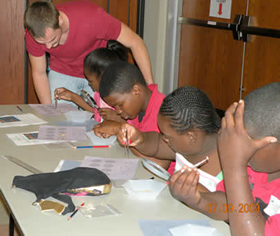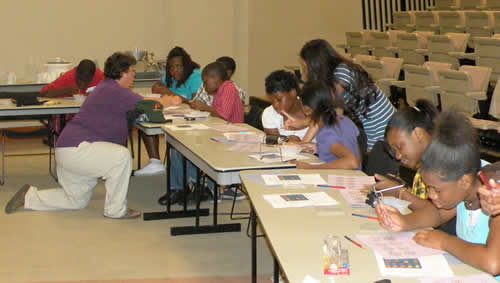Lee County Freedom School Field Trip
Opportunities for Educators and Schools

On July 9, 2009, sixty students, ranging from 5 to 14 years old, and ten adults from Lee County Freedom School in Marianna, Arkansas, visited the Dale Bumpers National Rice Research Center in Stuttgart, Arkansas. These children were part of the schools' 2009 summer program entitled, "Healthy Minds/Healthy Bodies." One of their goals was to learn where and how food is grown.
Nineteen of these students from grades five to eight were entrusted to Dr. Georgia Eizenga and staff. The goal was to teach the children about the diversity of rice, the nutritional value of rice and increase their interests in plant biology and plant science. By increasing this interest it is anticipated that a new generation of scientists and biologist will be produced.
Dr. Eizenga introduced the history of rice, and presented geographic and cultural information about the various types of rice that are part of the "Diversity Set" being evaluated in the research portion of this NSF-supported project. The information was based on the "Rice and Africa" materials developed by the Outreach group for middle school students.
Quynh Ho, USDA Biological Science Technician, visited with the students about growing up in Vietnam and how her daily life revolved around rice. She and the students also examined various rice products that can be purchased in the grocery store, as well as specialty products that are used in Asian and Middle Eastern cultures.

Teresa Hancock, technician supported by this project, and student interns, Grant Brock and Chance Jackson, worked with each student to phenotype their own sample of rice that contained a variety of grain types. Each student used tweezers, a magnifying glass and a ruler to closely examine and separate the rice kernels into various shapes, sizes and colors. Students were then encouraged to dehull the rice and observe the different colors of bran. Some students continued processing their sample by milling or polishing the kernels. They learned what rice looks like from the time it is harvested in the field to when it is purchased in the grocery store. These activities were based on the Genetic Diversity activities developed by the Outreach group.
The activity concluded with rice tasting. Students were encouraged to taste samples of black rice, brown rice and aromatic rice. While tasting the samples there was discussion about the nutritional values of the different kinds of rice. Brown and aromatic rice were favorites for the students.
Feedback from Lee County Freedom School indicates that the children retained the knowledge and were excited about their visit.
